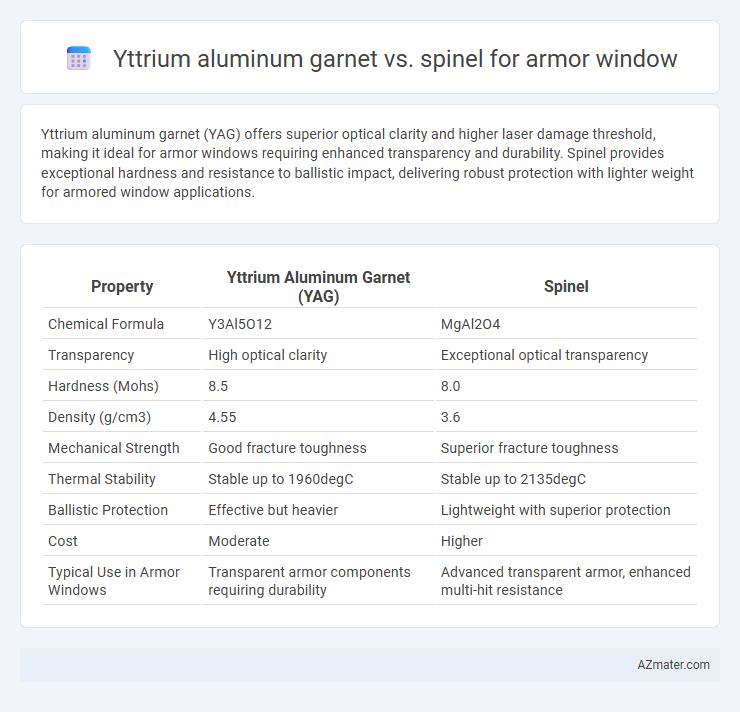Yttrium aluminum garnet (YAG) offers superior optical clarity and higher laser damage threshold, making it ideal for armor windows requiring enhanced transparency and durability. Spinel provides exceptional hardness and resistance to ballistic impact, delivering robust protection with lighter weight for armored window applications.
Table of Comparison
| Property | Yttrium Aluminum Garnet (YAG) | Spinel |
|---|---|---|
| Chemical Formula | Y3Al5O12 | MgAl2O4 |
| Transparency | High optical clarity | Exceptional optical transparency |
| Hardness (Mohs) | 8.5 | 8.0 |
| Density (g/cm3) | 4.55 | 3.6 |
| Mechanical Strength | Good fracture toughness | Superior fracture toughness |
| Thermal Stability | Stable up to 1960degC | Stable up to 2135degC |
| Ballistic Protection | Effective but heavier | Lightweight with superior protection |
| Cost | Moderate | Higher |
| Typical Use in Armor Windows | Transparent armor components requiring durability | Advanced transparent armor, enhanced multi-hit resistance |
Introduction to Transparent Armor Materials
Yttrium aluminum garnet (YAG) and Spinel are advanced transparent ceramic materials widely used in armor window applications due to their exceptional hardness and optical clarity. YAG offers high fracture toughness and thermal conductivity, making it suitable for high-impact protection, while Spinel provides superior chemical stability and optical transmittance across a broader wavelength range. These properties make YAG and Spinel critical choices for transparent armor systems in military and aerospace sectors where durability and visibility are paramount.
What is Yttrium Aluminum Garnet (YAG)?
Yttrium Aluminum Garnet (YAG) is a synthetic crystalline material known for its exceptional hardness, high optical clarity, and excellent resistance to thermal shock, making it suitable for armor window applications. Compared to Spinel, YAG offers superior mechanical strength and better transparency in the infrared spectrum, enhancing ballistic protection and optical performance. Its dense atomic structure and high melting point contribute to increased durability against impacts and environmental degradation in protective armor systems.
Defining Synthetic Spinel for Armor Applications
Synthetic spinel, a transparent polycrystalline ceramic composed of magnesium aluminate (MgAl2O4), exhibits exceptional hardness, high optical clarity, and superior ballistic performance, making it a prime candidate for armor window applications. Compared to yttrium aluminum garnet (YAG), synthetic spinel offers enhanced fracture toughness and greater resistance to thermal shock, resulting in improved durability under extreme impact conditions. Its lightweight nature combined with a high transmission range in the visible to infrared spectrum ensures optimal protection without compromising optical performance.
Optical Clarity: YAG vs. Spinel
Yttrium aluminum garnet (YAG) offers excellent optical clarity with high transparency in the visible and near-infrared spectrum, making it suitable for precise optical applications in armor windows. Spinel, while also highly transparent and durable, provides superior broadband optical transmission and better resistance to thermal shock, enhancing visibility under extreme conditions. Both materials deliver robust protection, but Spinel's wider transmission range and hardness often result in clearer, more reliable optical performance for high-stress armor window applications.
Ballistic Performance Comparison
Yttrium aluminum garnet (YAG) demonstrates superior ballistic performance compared to Spinel, offering higher hardness and better resistance to impact and penetration, making it ideal for armor windows. Spinel provides good optical clarity but exhibits lower fracture toughness and reduced resistance to high-velocity projectiles relative to YAG. The enhanced durability and energy absorption capabilities of YAG contribute to increased protection effectiveness against ballistic threats in transparent armor applications.
Mechanical Strength and Hardness
Yttrium aluminum garnet (YAG) exhibits a high mechanical strength with a hardness rating around 8.5 on the Mohs scale, making it highly resistant to mechanical stress and wear. Spinel, with a hardness of approximately 8.0, offers slightly lower mechanical strength but superior fracture toughness compared to YAG. Both materials are used in armor windows, with YAG providing excellent resistance to deformation and Spinel delivering enhanced durability against impact and thermal shock.
Thermal and Chemical Resistance
Yttrium aluminum garnet (YAG) exhibits superior thermal resistance with a melting point of approximately 1970degC and maintains structural integrity under high-temperature environments, making it ideal for armor windows exposed to extreme heat. Spinel offers excellent chemical resistance against corrosion and oxidation due to its stable oxide structure, ensuring durability in harsh chemical environments. Both materials provide robust performance, but YAG's higher thermal tolerance contrasts with Spinel's enhanced chemical stability, guiding material selection based on specific armor window exposure conditions.
Manufacturing and Cost Considerations
Yttrium aluminum garnet (YAG) exhibits high optical clarity and excellent thermal stability but involves complex manufacturing processes like single-crystal growth via the Czochralski method, resulting in higher production costs. Spinel is produced through sintering of nanocrystalline powders and hot isostatic pressing, offering cost-effective large-area windows with comparable optical performance and superior resistance to shock and abrasion. Evaluating manufacturing scalability and raw material availability, spinel generally presents a more economical choice for armor window applications despite YAG's marginally higher hardness and thermal conductivity.
Current Military and Civilian Uses
Yttrium aluminum garnet (YAG) provides superior optical clarity and high laser-induced damage threshold, making it ideal for military armor windows in high-energy laser weapon systems. Spinel armor windows offer excellent ballistic protection and scratch resistance, widely utilized in both military vehicle windshields and transparent armor for civilian aviation and security applications. Current trends emphasize YAG for advanced sensor and targeting systems, while spinel dominates in multi-hit resistance for frontline personnel and vehicle armor.
Future Trends in Transparent Armor Windows
Yttrium aluminum garnet (YAG) and spinel are advancing as critical materials in transparent armor windows due to their exceptional hardness and optical clarity. Future trends highlight spinel's increasing adoption because of its superior fracture toughness and resistance to high-velocity impacts compared to YAG, making it more suitable for next-generation military and aerospace applications. Research is focusing on enhancing the scalability and cost-effectiveness of spinel production while improving the laser damage threshold and thermal stability of YAG to meet evolving defense standards.

Infographic: Yttrium aluminum garnet vs Spinel for Armor window
 azmater.com
azmater.com